ignition Hyundai Elantra 2015 Owner's Manual - RHD (UK. Australia)
[x] Cancel search | Manufacturer: HYUNDAI, Model Year: 2015, Model line: Elantra, Model: Hyundai Elantra 2015Pages: 498, PDF Size: 9.45 MB
Page 24 of 498
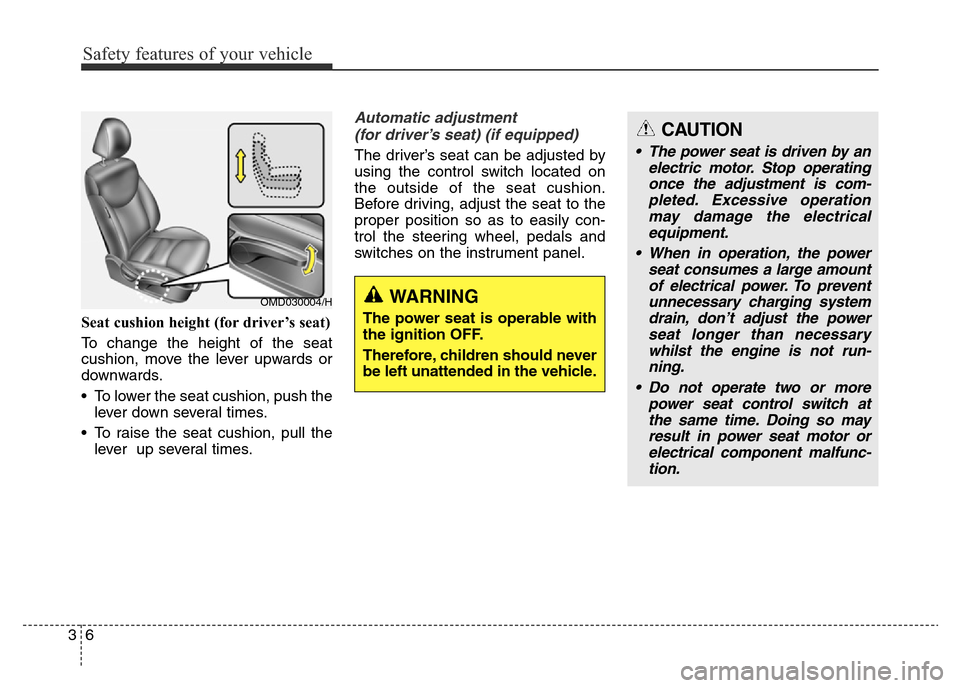
Safety features of your vehicle
6 3
Seat cushion height (for driver’s seat)
To change the height of the seat
cushion, move the lever upwards or
downwards.
• To lower the seat cushion, push the
lever down several times.
• To raise the seat cushion, pull the
lever up several times.
Automatic adjustment
(for driver’s seat) (if equipped)
The driver’s seat can be adjusted by
using the control switch located on
the outside of the seat cushion.
Before driving, adjust the seat to the
proper position so as to easily con-
trol the steering wheel, pedals and
switches on the instrument panel.
OMD030004/HWARNING
The power seat is operable with
the ignition OFF.
Therefore, children should never
be left unattended in the vehicle.
CAUTION
• The power seat is driven by an
electric motor. Stop operating
once the adjustment is com-
pleted. Excessive operation
may damage the electrical
equipment.
• When in operation, the power
seat consumes a large amount
of electrical power. To prevent
unnecessary charging system
drain, don’t adjust the power
seat longer than necessary
whilst the engine is not run-
ning.
• Do not operate two or more
power seat control switch at
the same time. Doing so may
result in power seat motor or
electrical component malfunc-
tion.
Page 29 of 498
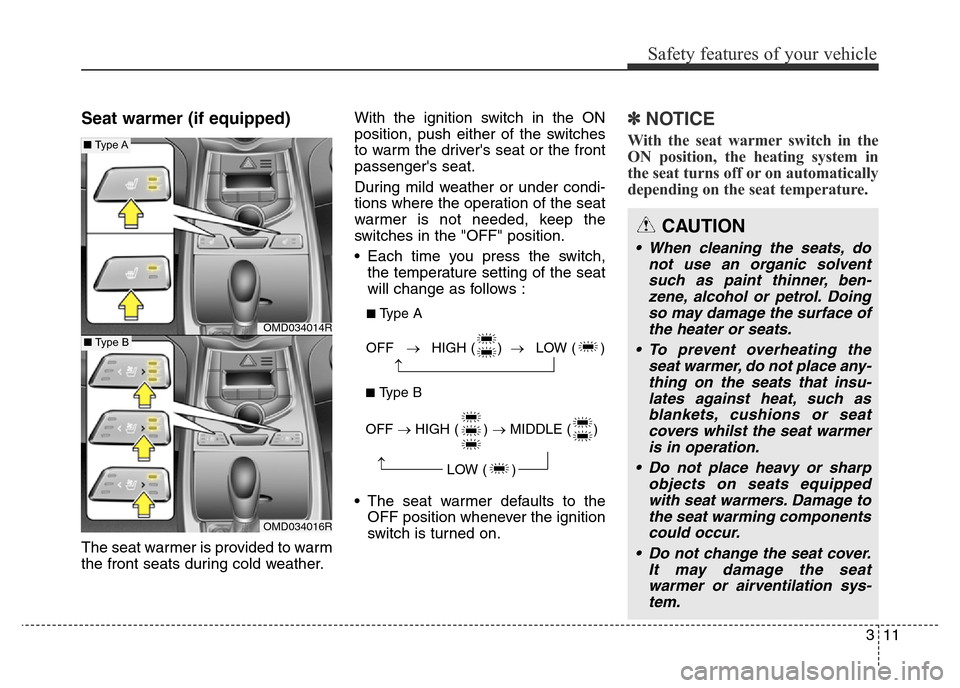
311
Safety features of your vehicle
Seat warmer (if equipped)
The seat warmer is provided to warm
the front seats during cold weather.With the ignition switch in the ON
position, push either of the switches
to warm the driver's seat or the front
passenger's seat.
During mild weather or under condi-
tions where the operation of the seat
warmer is not needed, keep the
switches in the "OFF" position.
• Each time you press the switch,
the temperature setting of the seat
will change as follows :
• The seat warmer defaults to the
OFF position whenever the ignition
switch is turned on.
✽NOTICE
With the seat warmer switch in the
ON position, the heating system in
the seat turns off or on automatically
depending on the seat temperature.
OMD034014R
OMD034016R
■Type A
■Type B
CAUTION
• When cleaning the seats, do
not use an organic solvent
such as paint thinner, ben-
zene, alcohol or petrol. Doing
so may damage the surface of
the heater or seats.
• To prevent overheating the
seat warmer, do not place any-
thing on the seats that insu-
lates against heat, such as
blankets, cushions or seat
covers whilst the seat warmer
is in operation.
• Do not place heavy or sharp
objects on seats equipped
with seat warmers. Damage to
the seat warming components
could occur.
• Do not change the seat cover.
It may damage the seat
warmer or airventilation sys-
tem.
OFF → HIGH ( ) → MIDDLE ( )
LOW ( )
OFF → HIGH ( ) → LOW ( )
→
→
■Type A
■Type B
Page 30 of 498
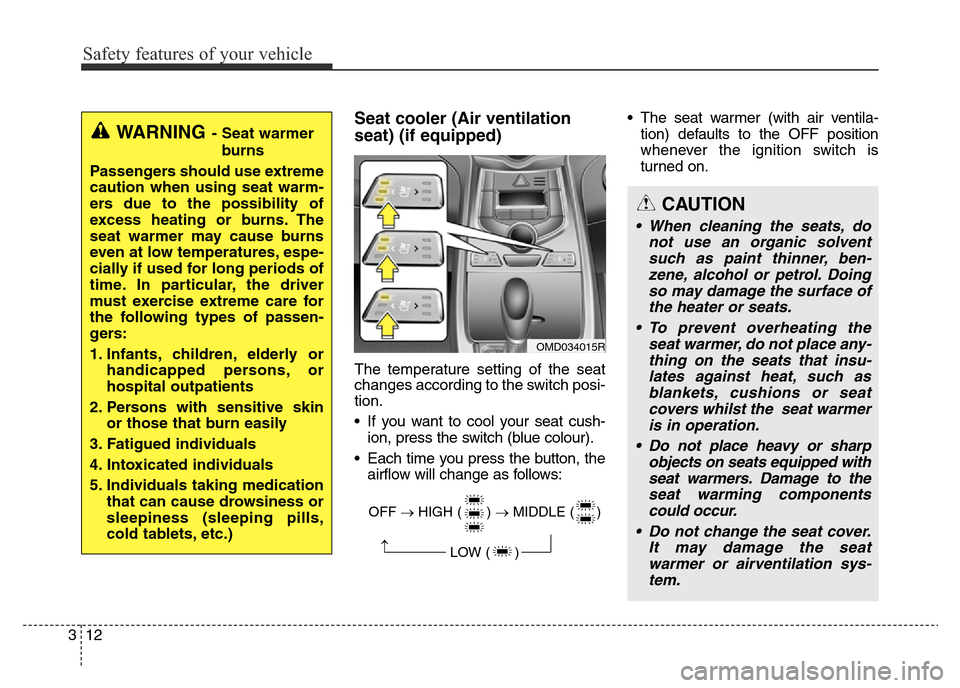
Safety features of your vehicle
12 3
Seat cooler (Air ventilation
seat) (if equipped)
The temperature setting of the seat
changes according to the switch posi-
tion.
• If you want to cool your seat cush-
ion, press the switch (blue colour).
• Each time you press the button, the
airflow will change as follows:• The seat warmer (with air ventila-
tion) defaults to the OFF position
whenever the ignition switch is
turned on.
OMD034015R
WARNING- Seat warmer
burns
Passengers should use extreme
caution when using seat warm-
ers due to the possibility of
excess heating or burns. The
seat warmer may cause burns
even at low temperatures, espe-
cially if used for long periods of
time. In particular, the driver
must exercise extreme care for
the following types of passen-
gers:
1. Infants, children, elderly or
handicapped persons, or
hospital outpatients
2. Persons with sensitive skin
or those that burn easily
3. Fatigued individuals
4. Intoxicated individuals
5. Individuals taking medication
that can cause drowsiness or
sleepiness (sleeping pills,
cold tablets, etc.)
CAUTION
• When cleaning the seats, do
not use an organic solvent
such as paint thinner, ben-
zene, alcohol or petrol. Doing
so may damage the surface of
the heater or seats.
• To prevent overheating the
seat warmer, do not place any-
thing on the seats that insu-
lates against heat, such as
blankets, cushions or seat
covers whilst the seat warmer
is in operation.
• Do not place heavy or sharp
objects on seats equipped with
seat warmers. Damage to the
seat warming components
could occur.
• Do not change the seat cover.
It may damage the seat
warmer or airventilation sys-
tem.
OFF → HIGH ( ) → MIDDLE ( )
LOW ( )
→
Page 33 of 498
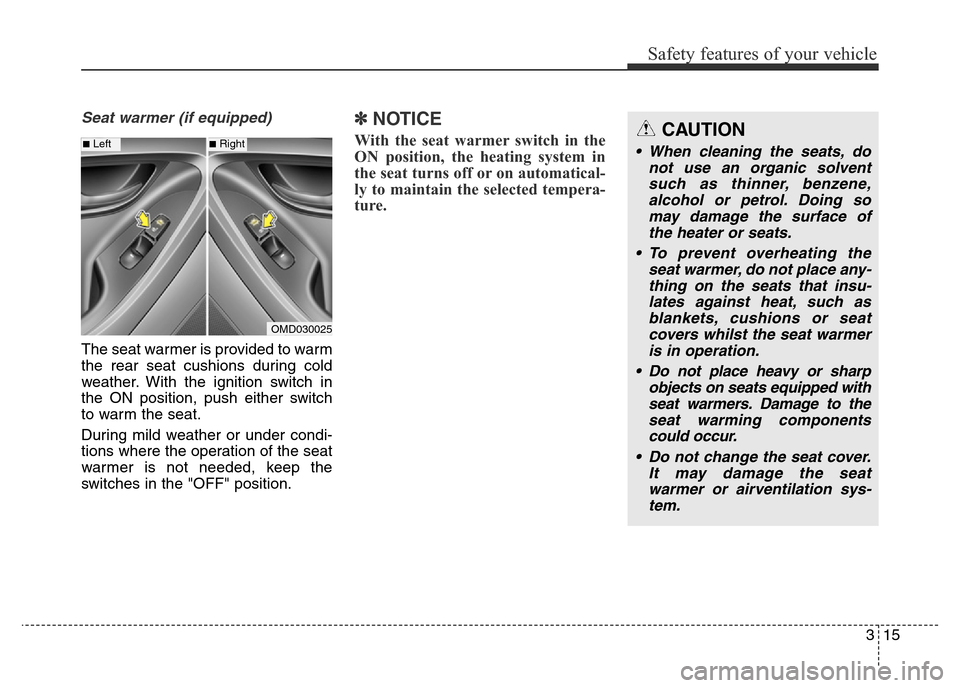
315
Safety features of your vehicle
Seat warmer (if equipped)
The seat warmer is provided to warm
the rear seat cushions during cold
weather. With the ignition switch in
the ON position, push either switch
to warm the seat.
During mild weather or under condi-
tions where the operation of the seat
warmer is not needed, keep the
switches in the "OFF" position.
✽NOTICE
With the seat warmer switch in the
ON position, the heating system in
the seat turns off or on automatical-
ly to maintain the selected tempera-
ture.
OMD030025
■Left■RightCAUTION
• When cleaning the seats, do
not use an organic solvent
such as thinner, benzene,
alcohol or petrol. Doing so
may damage the surface of
the heater or seats.
• To prevent overheating the
seat warmer, do not place any-
thing on the seats that insu-
lates against heat, such as
blankets, cushions or seat
covers whilst the seat warmer
is in operation.
• Do not place heavy or sharp
objects on seats equipped with
seat warmers. Damage to the
seat warming components
could occur.
• Do not change the seat cover.
It may damage the seat
warmer or airventilation sys-
tem.
Page 40 of 498
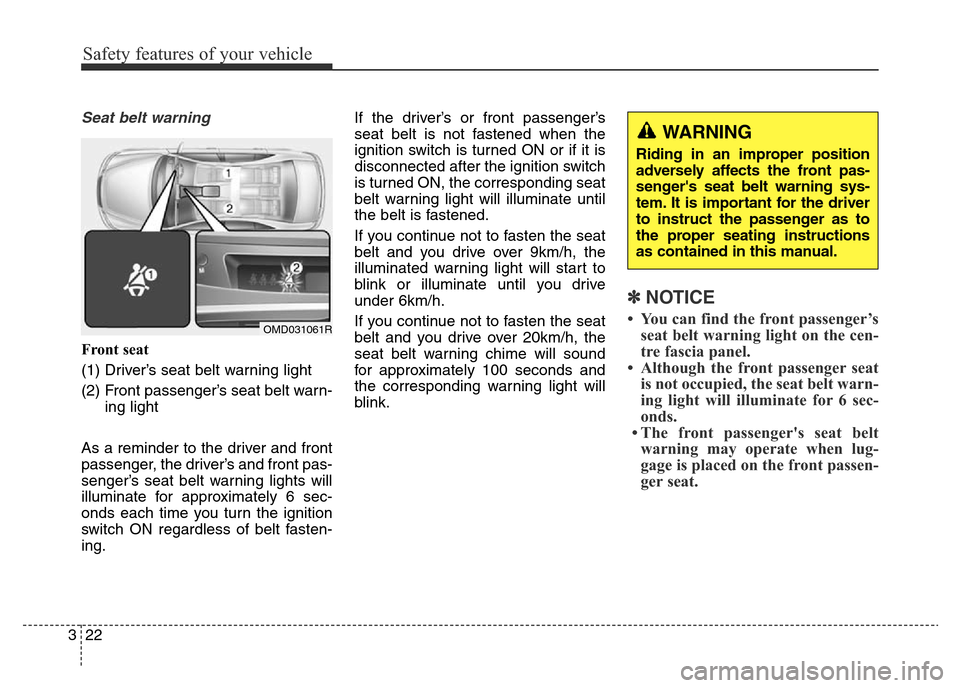
Safety features of your vehicle
22 3
Seat belt warning
Front seat
(1) Driver’s seat belt warning light
(2) Front passenger’s seat belt warn-
ing light
As a reminder to the driver and front
passenger, the driver’s and front pas-
senger’s seat belt warning lights will
illuminate for approximately 6 sec-
onds each time you turn the ignition
switch ON regardless of belt fasten-
ing.If the driver’s or front passenger’s
seat belt is not fastened when the
ignition switch is turned ON or if it is
disconnected after the ignition switch
is turned ON, the corresponding seat
belt warning light will illuminate until
the belt is fastened.
If you continue not to fasten the seat
belt and you drive over 9km/h, the
illuminated warning light will start to
blink or illuminate until you drive
under 6km/h.
If you continue not to fasten the seat
belt and you drive over 20km/h, the
seat belt warning chime will sound
for approximately 100 seconds and
the corresponding warning light will
blink.
✽NOTICE
• You can find the front passenger’s
seat belt warning light on the cen-
tre fascia panel.
• Although the front passenger seat
is not occupied, the seat belt warn-
ing light will illuminate for 6 sec-
onds.
• The front passenger's seat belt
warning may operate when lug-
gage is placed on the front passen-
ger seat.OMD031061R
WARNING
Riding in an improper position
adversely affects the front pas-
senger's seat belt warning sys-
tem. It is important for the driver
to instruct the passenger as to
the proper seating instructions
as contained in this manual.
Page 41 of 498
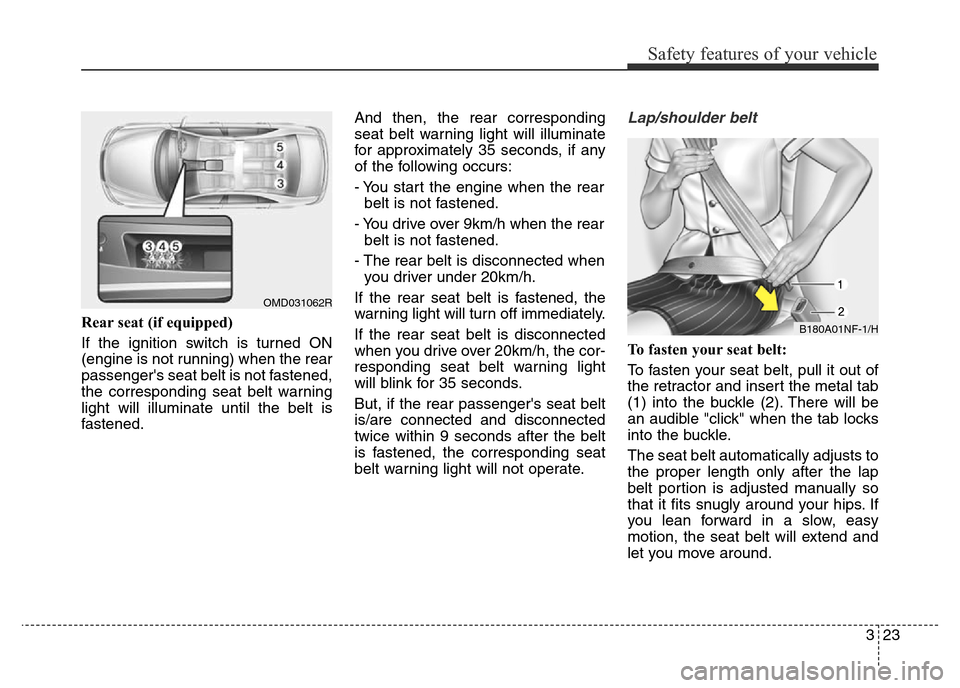
323
Safety features of your vehicle
Rear seat (if equipped)
If the ignition switch is turned ON
(engine is not running) when the rear
passenger's seat belt is not fastened,
the corresponding seat belt warning
light will illuminate until the belt is
fastened.And then, the rear corresponding
seat belt warning light will illuminate
for approximately 35 seconds, if any
of the following occurs:
- You start the engine when the rear
belt is not fastened.
- You drive over 9km/h when the rear
belt is not fastened.
- The rear belt is disconnected when
you driver under 20km/h.
If the rear seat belt is fastened, the
warning light will turn off immediately.
If the rear seat belt is disconnected
when you drive over 20km/h, the cor-
responding seat belt warning light
will blink for 35 seconds.
But, if the rear passenger's seat belt
is/are connected and disconnected
twice within 9 seconds after the belt
is fastened, the corresponding seat
belt warning light will not operate.
Lap/shoulder belt
To fasten your seat belt:
To fasten your seat belt, pull it out of
the retractor and insert the metal tab
(1) into the buckle (2). There will be
an audible "click" when the tab locks
into the buckle.
The seat belt automatically adjusts to
the proper length only after the lap
belt portion is adjusted manually so
that it fits snugly around your hips. If
you lean forward in a slow, easy
motion, the seat belt will extend and
let you move around.
OMD031062R
B180A01NF-1/H
Page 45 of 498
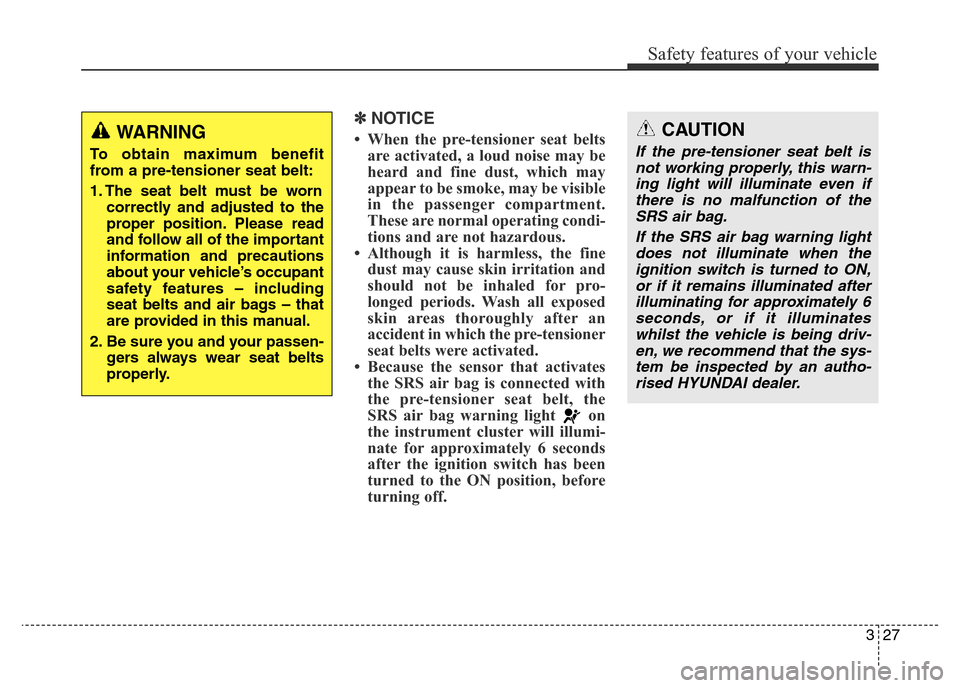
327
Safety features of your vehicle
✽NOTICE
• When the pre-tensioner seat belts
are activated, a loud noise may be
heard and fine dust, which may
appear to be smoke, may be visible
in the passenger compartment.
These are normal operating condi-
tions and are not hazardous.
• Although it is harmless, the fine
dust may cause skin irritation and
should not be inhaled for pro-
longed periods. Wash all exposed
skin areas thoroughly after an
accident in which the pre-tensioner
seat belts were activated.
• Because the sensor that activates
the SRS air bag is connected with
the pre-tensioner seat belt, the
SRS air bag warning light on
the instrument cluster will illumi-
nate for approximately 6 seconds
after the ignition switch has been
turned to the ON position, before
turning off.WARNING
To obtain maximum benefit
from a pre-tensioner seat belt:
1. The seat belt must be worn
correctly and adjusted to the
proper position. Please read
and follow all of the important
information and precautions
about your vehicle’s occupant
safety features – including
seat belts and air bags – that
are provided in this manual.
2. Be sure you and your passen-
gers always wear seat belts
properly.
CAUTION
If the pre-tensioner seat belt is
not working properly, this warn-
ing light will illuminate even if
there is no malfunction of the
SRS air bag.
If the SRS air bag warning light
does not illuminate when the
ignition switch is turned to ON,
or if it remains illuminated after
illuminating for approximately 6
seconds, or if it illuminates
whilst the vehicle is being driv-
en, we recommend that the sys-
tem be inspected by an autho-
rised HYUNDAI dealer.
Page 61 of 498
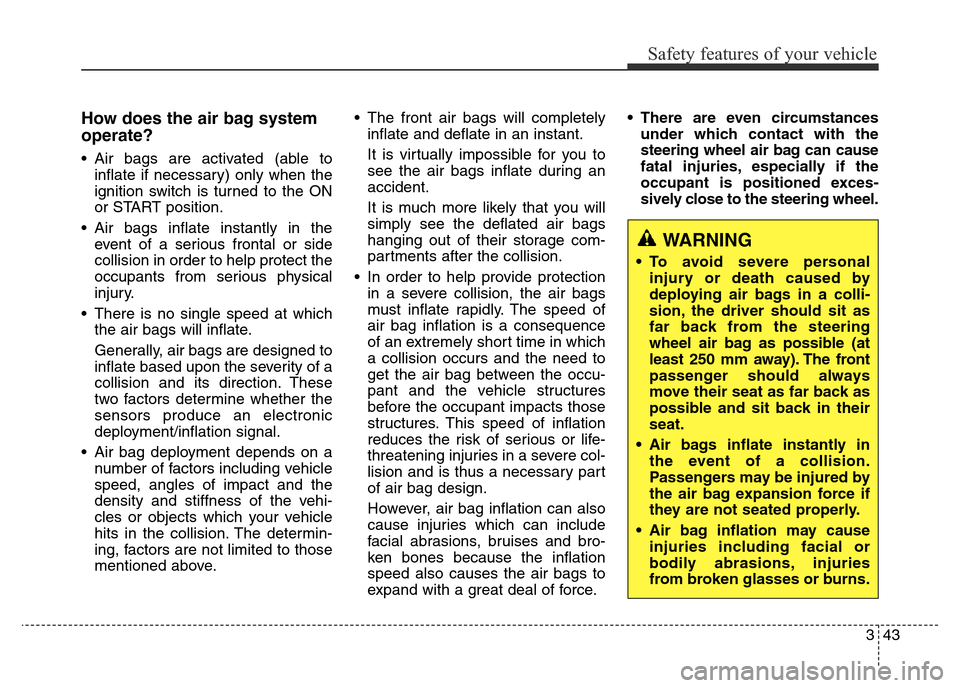
343
Safety features of your vehicle
How does the air bag system
operate?
• Air bags are activated (able to
inflate if necessary) only when the
ignition switch is turned to the ON
or START position.
• Air bags inflate instantly in the
event of a serious frontal or side
collision in order to help protect the
occupants from serious physical
injury.
• There is no single speed at which
the air bags will inflate.
Generally, air bags are designed to
inflate based upon the severity of a
collision and its direction. These
two factors determine whether the
sensors produce an electronic
deployment/inflation signal.
• Air bag deployment depends on a
number of factors including vehicle
speed, angles of impact and the
density and stiffness of the vehi-
cles or objects which your vehicle
hits in the collision. The determin-
ing, factors are not limited to those
mentioned above.• The front air bags will completely
inflate and deflate in an instant.
It is virtually impossible for you to
see the air bags inflate during an
accident.
It is much more likely that you will
simply see the deflated air bags
hanging out of their storage com-
partments after the collision.
• In order to help provide protection
in a severe collision, the air bags
must inflate rapidly. The speed of
air bag inflation is a consequence
of an extremely short time in which
a collision occurs and the need to
get the air bag between the occu-
pant and the vehicle structures
before the occupant impacts those
structures. This speed of inflation
reduces the risk of serious or life-
threatening injuries in a severe col-
lision and is thus a necessary part
of air bag design.
However, air bag inflation can also
cause injuries which can include
facial abrasions, bruises and bro-
ken bones because the inflation
speed also causes the air bags to
expand with a great deal of force.• There are even circumstances
under which contact with the
steering wheel air bag can cause
fatal injuries, especially if the
occupant is positioned exces-
sively close to the steering wheel.
WARNING
• To avoid severe personal
injury or death caused by
deploying air bags in a colli-
sion, the driver should sit as
far back from the steering
wheel air bag as possible (at
least 250 mm away). The front
passenger should always
move their seat as far back as
possible and sit back in their
seat.
• Air bags inflate instantly in
the event of a collision.
Passengers may be injured by
the air bag expansion force if
they are not seated properly.
• Air bag inflation may cause
injuries including facial or
bodily abrasions, injuries
from broken glasses or burns.
Page 62 of 498
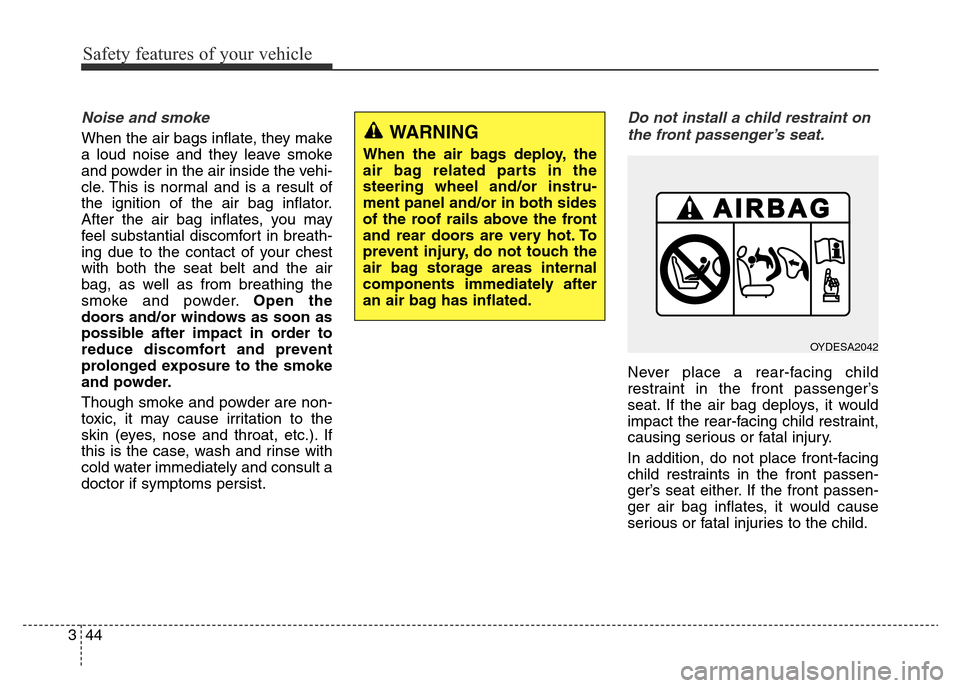
Safety features of your vehicle
44 3
Noise and smoke
When the air bags inflate, they make
a loud noise and they leave smoke
and powder in the air inside the vehi-
cle. This is normal and is a result of
the ignition of the air bag inflator.
After the air bag inflates, you may
feel substantial discomfort in breath-
ing due to the contact of your chest
with both the seat belt and the air
bag, as well as from breathing the
smoke and powder.Open the
doors and/or windows as soon as
possible after impact in order to
reduce discomfort and prevent
prolonged exposure to the smoke
and powder.
Though smoke and powder are non-
toxic, it may cause irritation to the
skin (eyes, nose and throat, etc.). If
this is the case, wash and rinse with
cold water immediately and consult a
doctor if symptoms persist.
Do not install a child restraint on
the front passenger’s seat.
Never place a rear-facing child
restraint in the front passenger’s
seat. If the air bag deploys, it would
impact the rear-facing child restraint,
causing serious or fatal injury.
In addition, do not place front-facing
child restraints in the front passen-
ger’s seat either. If the front passen-
ger air bag inflates, it would cause
serious or fatal injuries to the child.
WARNING
When the air bags deploy, the
air bag related parts in the
steering wheel and/or instru-
ment panel and/or in both sides
of the roof rails above the front
and rear doors are very hot. To
prevent injury, do not touch the
air bag storage areas internal
components immediately after
an air bag has inflated.
OYDESA2042
Page 63 of 498
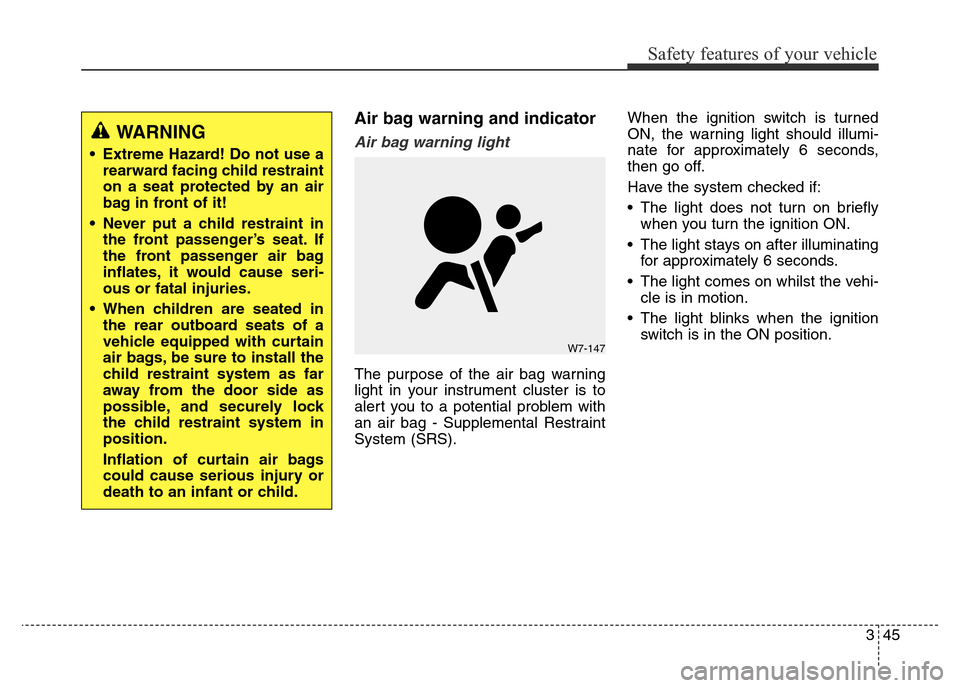
345
Safety features of your vehicle
Air bag warning and indicator
Air bag warning light
The purpose of the air bag warning
light in your instrument cluster is to
alert you to a potential problem with
an air bag - Supplemental Restraint
System (SRS).When the ignition switch is turned
ON, the warning light should illumi-
nate for approximately 6 seconds,
then go off.
Have the system checked if:
• The light does not turn on briefly
when you turn the ignition ON.
• The light stays on after illuminating
for approximately 6 seconds.
• The light comes on whilst the vehi-
cle is in motion.
• The light blinks when the ignition
switch is in the ON position.
WARNING
• Extreme Hazard! Do not use a
rearward facing child restraint
on a seat protected by an air
bag in front of it!
• Never put a child restraint in
the front passenger’s seat. If
the front passenger air bag
inflates, it would cause seri-
ous or fatal injuries.
• When children are seated in
the rear outboard seats of a
vehicle equipped with curtain
air bags, be sure to install the
child restraint system as far
away from the door side as
possible, and securely lock
the child restraint system in
position.
Inflation of curtain air bags
could cause serious injury or
death to an infant or child.
W7-147